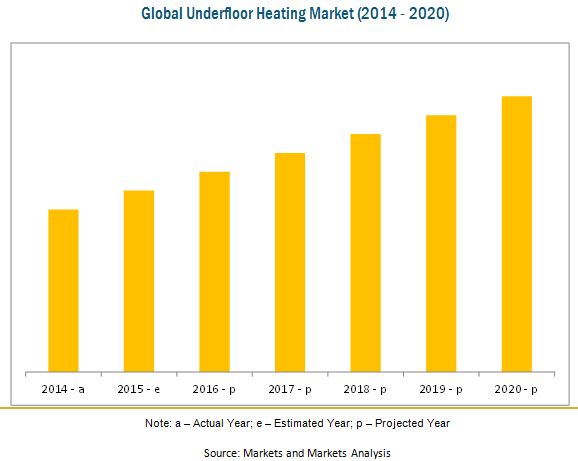Currently, Europe holds the large share in the underfloor heating market, followed by North America and APAC. The said market in Europe is expected to grow at the highest CAGR of 10.5% between 2015 and 2020, to reach USD 3.46 billion by 2020. The European market of UFH is growing rapidly as it is moving towards a low-carbon economy and due to the growth of environmental and energy-efficiency concerns. Also, higher levels of insulation, driven by regulatory requirements and initiatives, are contributing to a reduction in the overall heating load, making UFH a more practical and efficient heating solution in Europe. The global underfloor heating market report along with its subsegments such as market by type, facility, application, and geography provides valuable insights into the said market and forecasts the same till 2020.
There are a number of players in the underfloor heating market such as Danfoss A/S (Denmark), Uponor Corporation (Finland), Emerson Electric Co. (U.S.), Honeywell International Inc. (U.S.), Robert Bosch (Germany), Pentair PLC (U.K.), Mitsubishi Electric (Tokyo), Schneider Electric SE (France), and Nexans S.A. (France).
The underfloor heating market has gained momentum in the recent past because of the increased installations in a wide range of commercial, industrial, and residential buildings on account of its high energy efficiency and cost effectiveness, along with the steady growth of the infrastructure sector, globally. The growth of the underfloor heating market is mainly being driven by the increase in the number of policies and government regulations regarding the use of energy-efficient technologies and solutions in the buildings due to increasing concerns about energy efficiency and the global environment. These guidelines and implementation measures have contributed majorly to the growth in the demand for energy-efficient underfloor heating systems in various applications such as commercial, industrial, and residential.
Underfloor heating is considered to be highly versatile since it is suitable for installation under diverse range of flooring types such as tiles, stone, carpet, wood, and laminate. The wider use of hard flooring allows greater energy savings with UFH as systems are more efficient with hard flooring. It is also compatible with renewable energy sources and provides cost-effective comfort and safety in a variety of installations. Underfloor heating provides increased energy efficiency, significantly reduces operating costs, and contributes substantially to climate and environmental protection along with high level of comfort. The major types of underfloor heating systems are hydronic underfloor heating systems and electric underfloor heating systems. The hydronic UFH system relies on hot water for in-floor heating. The electric underfloor heating system functions just like an electric blanket where heat is created when electricity runs through the resistance cable.
The commercial and residential sectors are expected to be the major applications of underfloor heating systems, thereby contributing to the growth of this market. New buildings are expected to contribute highly to the underfloor heating market. The market for electric UFH systems is expected to grow at a high CAGR of 10.0% between 2015 and 2020. The electric UFH systems is showing high growth rate because it is less costly to install and is easier to retrofit, with many systems available which do not require an insulating screed. Systems can also easily be fitted into a single room, particularly where wireless controls are used, which do not require digging wall channels. Electric UFH systems also exert less load on floors so can be easily fitted in the rooms and flats which are upstairs.

